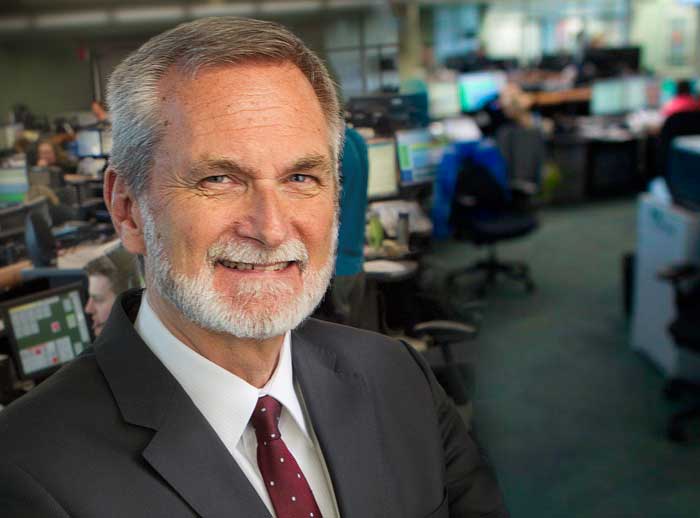New consolidated 9-1-1/police dispatch centre
New consolidated 9-1-1/police dispatch centre to enhance public safety


In an effort to enhance 9-1-1 call-answer and police dispatch services on Southern Vancouver Island, police agencies in Greater Victoria and the Capital Regional District (CRD) will join forces and operate out of a new shared state-of-the-art post-disaster facility.
The new South Island Dispatch Centre will be the first point of contact for 9-1-1 callers on South Vancouver Island and will also house police call-taking and dispatch for the Victoria, Saanich, Central Saanich and Oak Bay police departments as well as all local RCMP detachments. Construction of the new centre will begin later in 2017 with the centre expected to be operational in 2019.
“We are confident that this project will improve service to the public, increase officer safety and provide efficiencies for local governments, police and the RCMP.”
Barbara Desjardins,
CRD Board Chair
“CRD staff have been working hard with the South Island Police Dispatch Steering Committee to finalize facility planning for this new dispatch centre and we look forward to breaking ground in 2017,” said Barbara Desjardins, CRD Board Chair. “We are confident that this project will improve service to the public, increase officer safety and provide efficiencies for local governments, police and the RCMP.”
The facility will be located in Saanich and managed by E-Comm which will oversee 9-1-1 call-answer services for southern Vancouver Island and police call-taking and dispatch operations for the five police agencies within the region. With 18 years’ experience as a 9-1-1 Primary Public Safety Answer Point and dispatch centre, E-Comm has managed more than 17-million 9-1-1 calls and earned a reputation as a leading emergency communications centre in North America. E-Comm President and CEO David Guscott spoke about how the organization is looking forward to supporting its South Island partners.
“Our goal is to provide residents and officers in Greater Victoria, and the CRD, with high-quality and effective service. We are proud to be their partners in public safety.”
David Guscott,
E-Comm President and CEO
“We’re eager to start work on this project and to welcome the region’s existing 9-1-1 call-takers and dispatchers to the E-Comm team,” said Guscott. “Our goal is to provide residents and officers in Greater Victoria, and the CRD, with high-quality and effective service. We are proud to be their partners in public safety.”
2018 will also see E-Comm continue to expand its public safety services within the Lower Mainland, following two new partnership announcements.

Coquitlam Fire/Rescue recently confirmed that the department plans to transition its call-taking and dispatch services to 9-1-1 While a transition date is yet to be confirmed, Fire Chief Wade Pierlot advised the decision to integrate with the emergency communications centre was made following a comprehensive review of the department’s current operations. The review determined that a move would allow them to continue to deliver safe and efficient emergency response well into the future. Coquitlam Fire/Rescue will be the 19th fire department to join E-Comm’s dispatch family.
The Township of Langley Fire Department has also decided to join the regional radio system and is currently scheduled to transition in February 2018. This will mean that for the first time, firefighters, police officers and paramedics within the Township will be able to communicate over the same radio system. This will be extremely helpful during mutual-aid events such as motor vehicle incidents. As Fire Chief Stephen Gamble explains, the move will provide his firefighters with enhanced communication capabilities when out in the field. “Firefighters work in hazardous situations, locations and weather, where communication is relied upon to successfully protect our staff and the public. The features of the new radio system are a welcome addition to our existing tools and the skills of our firefighters,” he says.
“Being a part of E-Comm’s next generation radio system will benefit both operations and safety. A radio is literally a lifeline.”
Mayor Jack Froese,
Township of Langley
Township of Langley Mayor Jack Froese, a former Vancouver Police Officer, agrees. “The safety of first responders and the public they serve is a top priority for the Township,” adds Mayor Froese, who is also a member of E-Comm’s Board of Directors. “I understand the rigorous conditions firefighters work in and being a part of E-Comm’s next generation radio system will benefit both operations and safety. A radio is literally a lifeline.”
The Township of Langley Fire Department will be the 13th fire department to join E-Comm’s radio system. The Langley RCMP has been a radio partner since 2002 and BC Emergency Health Services has been using the radio system for the ambulance service since 2000. Both are scheduled to move to the “next generation radio system” later this year, and once the Township’s fire department joins in 2018 all three agencies will be able to communicate together in real-time.
Find out more about E-Comm’s services and stay up to date on news and announcements by visiting ecomm911.ca.
Next generation radio network
Next generation radio network receives final approval


E-Comm’s first quarter ended with a major milestone for the Next Generation Radio Program (NGRP) and the planned replacement of the regional radio system, as the emergency communications centre and Motorola Solutions Canada officially signed off on the new network—confirming the system is ready for agency use. The Baseline Provisional Acceptance was signed on March 31 and less than a week later the first of 32 emergency-service agencies began transitioning to the new P25 network.
“The amount of work that got us to this point cannot be overstated,” explained E-Comm’s Vice-President of Technology Services Mike Webb. “After five years of tireless efforts from our staff and public safety partners involved in the NGRP project, we were able to officially declare the network is ready to carry live traffic and that the design and functionality of the system meets the expectations and needs of first responders.”
Leading up to the final network acceptance, extensive testing was completed with resources from Motorola working closely with E-Comm’s wireless and engineering teams to ensure the overall network design and links between radio sites and dispatch centres were all running seamlessly. Signal strength was also a critical part of the testing process and an important step leading up to network approval. Because the new system includes a number of new radio sites designed to provide increased coverage, E-Comm’s engineering team spent a considerable amount of time ensuring wireless coverage and audio clarity met the design objectives within each jurisdiction.
“With the improved coverage and features of the new network we know public and responder safety will be enhanced throughout municipalities where police, fire and ambulance agencies are using the radio system,” added Webb.
Webb was among those who signed the Baseline Provisional Acceptance and credits a big part of this success to the involvement of emergency-service agencies. “None of this would have been possible without the collaboration and contribution of our partners. I really want to thank those involved for lending their experience, expertise and knowledge over the past number of years.”
Agency transitions officially began on April 5 and are scheduled in a phased approach through to the end of the year. The new radio system will be used by police departments and BC Emergency Health Services in Metro Vancouver and Abbotsford, in addition to 12 fire departments in Metro Vancouver and the BC Conservation Service.
CEO Update


E-Comm began the year by joining Greater Victoria’s police leadership, the Capital Regional District and provincial government in announcing a new consolidated 9-1-1 and police dispatch centre for southern Vancouver Island. As part of this initiative, I’m proud to report that E-Comm will be managing the state-of-the-art facility on behalf of the police agencies within the Capital Regional District.
E-Comm will be responsible for 9-1-1 call-answer services for the South Island and call-taking and dispatch services for the Victoria, Saanich, Central Saanich and Oak Bay police departments and West Shore RCMP.
This exciting project will considerably shift the public-safety landscape in the region—enhancing emergency communications and providing increased benefits through the advantages of consolidation: Increased capacity, a larger workforce capable of scaling up during major events and improved operational and technical redundancy. This also marks a major milestone for E-Comm, one that allows us to strengthen our public safety role in B.C. through our public safety services and technology. It is an opportunity our organization—with the full support of our Board of Directors—is proud to move forward with in conjunction with our South Island partners.
In other E-Comm news, after receiving final approval on the overall design and functionality of the new P25 digital radio network, known as the Next Generation Radio Program (NGRP), emergency service agencies in the Lower Mainland began moving onto the system in April. E-Comm’s Wireless team has been working hard to address challenges that naturally arise with a technology project of this magnitude. We look forward to sharing more details on agency transitions in our next issue.
I’m pleased to report that through careful planning and due diligence, the NGRP $60 Million capital project will not result in any spike in annual radio levies. This demonstrates the value of E-Comm’s cooperative model and illustrates the ongoing commitment we have to providing our shareholders (radio members) with high-quality public safety services in the most cost effective way possible.
On the topic of service excellence, E-Comm was gratified to learn that the results of our annual public confidence survey once again demonstrates a high degree of satisfaction in the services our organization provides. In a poll of approximately 500 residents of Metro Vancouver in December, 91% of respondents reported that they have confidence in the 9-1-1 and dispatch services provided by E-Comm. That high level of confidence would not be possible without the hard work and dedication of our employees and partners in public safety, and I would like to express my personal thanks for everyone’s efforts.
This spring we welcomed our newest 9-1-1 Primary Public Safety Answer Point partners in the Peace River Regional District. Following a seamless transition on May 17, E-Comm became the first point of contact for 9-1-1 callers in Fort St. John, Dawson Creek, Chetwynd, Hudson’s Hope, Pouce Coupe, Taylor and Tumbler Ridge along with many of the region’s First Nations communities. Approximately 20,000 calls per year from the Peace Region are now answered by one of our highly-skilled 9-1-1 call-takers who then transfer calls to the requested police, fire or ambulance agency so they can get the help they need.
The concept of E-Comm
“The concept of E-Comm intrigued me from the beginning.”


A partner with professional services firm Ernst & Young LLP, Doug Campbell has more than 20 years’ experience in the consulting industry and was appointed as E-Comm’s Board Chair in June 2016.
When did you first learn about E-Comm?
Back in the early 1990s when the idea of consolidated emergency communications was first being discussed, I was part of a team of consultants that worked closely with Ken Dobell—the influential City Manager of the City of Vancouver. Ken was leading the charge in the development of a multi-agency, multi-jurisdictional radio system for our region that eventually led to the formation of E-Comm.
The whole concept of E-Comm intrigued me from the beginning, and the fact that 18 years later we have this organization that is so widely respected by the public safety industry for the value it provides to our province is incredible. I find the story of E-Comm and how we got here very inspiring.
As a former military engineer officer with the Canadian Armed Forces, I have always had an interest in public safety and a strong desire to help others and contribute to a higher calling—a shared purpose I see in the people who work at E-Comm. Whether it’s replacing the regional radio system, answering or dispatching emergency calls, conducting public education outreach, ensuring cost effectiveness and high value for our stakeholders or hiring staff to suit the unique nature of our business—everyone is working hard to help achieve the vision of the company; safer communities in B.C. through communication excellence.
What are some highlights for you so far?
The first time I visited the communication centre what struck me the most was how seamless staff made everything look. It was on one of the very busy annual fireworks festival nights in Vancouver, and I was impressed at how well all of the different roles worked together to support each other and ensure callers got the help they needed. Things started to get really busy for the team after the fireworks ended and hundreds of thousands of people began making their way home, but whether it was a minor incident or a serious situation staff kept calm and dealt with everything in a very comfortable and professional manner.
What have you learned about E-Comm (and public safety) that you didn’t know before?
Back in my army days we used to talk a lot about the value of an “all arms” approach; combining different resources in order to achieve maximum results. I see the staff here at E-Comm as part of an emergency services “all arms” team. Their daily contribution to public safety is tremendously valued by our partners and stakeholders.

What are some of your goals for your first term as Board Chair?
A top priority for me in the first half of 2017 has been overseeing the recruitment of E-Comm’s new CEO, following David Guscott’s retirement announcement. The Board of Directors has begun the search for David’s successor and we appreciate the lengthy notice period he gave us to allow for a smooth transition. An executive search firm has been engaged to conduct a national search, and l know we will recruit a great new CEO who will help to navigate the challenges and opportunities in front of us.
“I have always had an interest in public safety and a strong desire to help others and contribute to a higher calling—a shared purpose I see in the people who work at E-Comm.”
E-Comm Board Chair Doug Campbell
The Next Generation Radio Program and replacement of the regional radio system is going to be a top priority for the year as agencies start to transition to the new system. In talking to our emergency-service partners I know everyone is keen to start the implementation process and I want to be able to do whatever I can to help facilitate the success of this significant project.
We also know that a major area of focus for the Board in 2017 is going to be strategic planning and the evolution of Vision 2020 and its strategies around employee engagement, organizational effectiveness, leadership, service excellence and expansion. I’m the type of person who likes to dream big, so I’m definitely excited about participating in the development of E-Comm’s next roadmap and looking at future possibilities for the company. Because the organization is shaped by the needs of our stakeholders, as Board Chair my job is to help advance E-Comm and our leadership role in public safety. Throughout 2017 I plan to meet with stakeholders to better understand their needs and ensure everyone is aligned with where the service needs to go.
E-Comm in the community




